Hyundai H350 2015 Owner's Manual
Manufacturer: HYUNDAI, Model Year: 2015, Model line: H350, Model: Hyundai H350 2015Pages: 473, PDF Size: 26.4 MB
Page 451 of 473
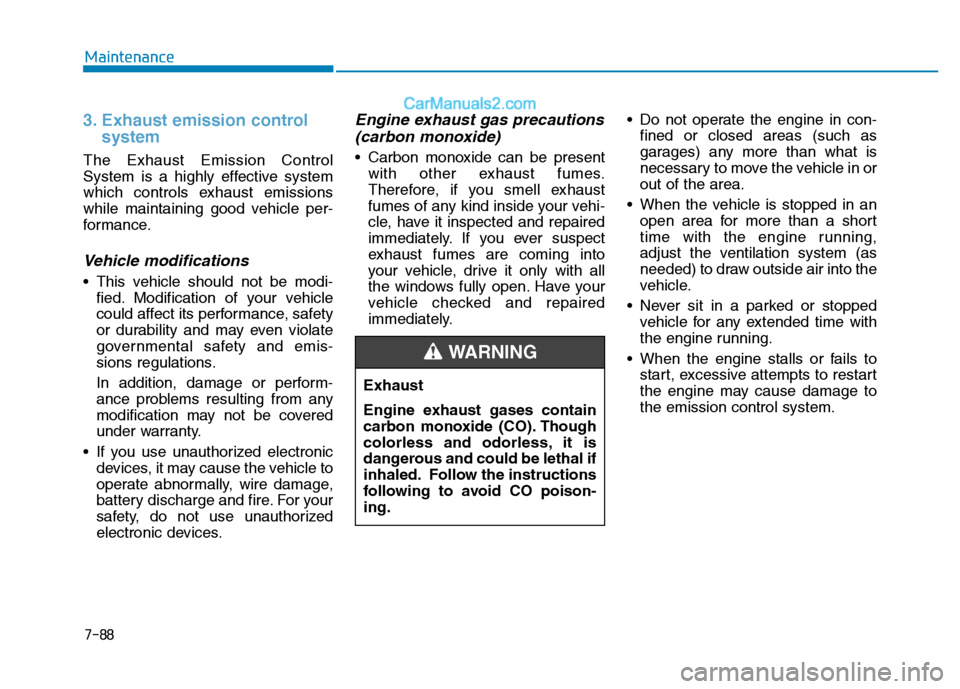
7-88
Maintenance
3. Exhaust emission control system
The Exhaust Emission Control
System is a highly effective system
which controls exhaust emissions
while maintaining good vehicle per-
formance.
Vehicle modifications
This vehicle should not be modi-fied. Modification of your vehicle
could affect its performance, safety
or durability and may even violate
governmental safety and emis-
sions regulations.
In addition, damage or perform-
ance problems resulting from any
modification may not be covered
under warranty.
If you use unauthorized electronic devices, it may cause the vehicle to
operate abnormally, wire damage,
battery discharge and fire. For your
safety, do not use unauthorized
electronic devices.
Engine exhaust gas precautions
(carbon monoxide)
Carbon monoxide can be present with other exhaust fumes.
Therefore, if you smell exhaust
fumes of any kind inside your vehi-
cle, have it inspected and repaired
immediately. If you ever suspect
exhaust fumes are coming into
your vehicle, drive it only with all
the windows fully open. Have your
vehicle checked and repaired
immediately. Do not operate the engine in con-
fined or closed areas (such as
garages) any more than what is
necessary to move the vehicle in orout of the area.
When the vehicle is stopped in an open area for more than a short
time with the engine running,
adjust the ventilation system (as
needed) to draw outside air into the
vehicle.
Never sit in a parked or stopped vehicle for any extended time with
the engine running.
When the engine stalls or fails to start, excessive attempts to restart
the engine may cause damage tothe emission control system.
Exhaust
Engine exhaust gases contain
carbon monoxide (CO). Though
colorless and odorless, it is
dangerous and could be lethal if
inhaled. Follow the instructions
following to avoid CO poison-ing.
WARNING
Page 452 of 473
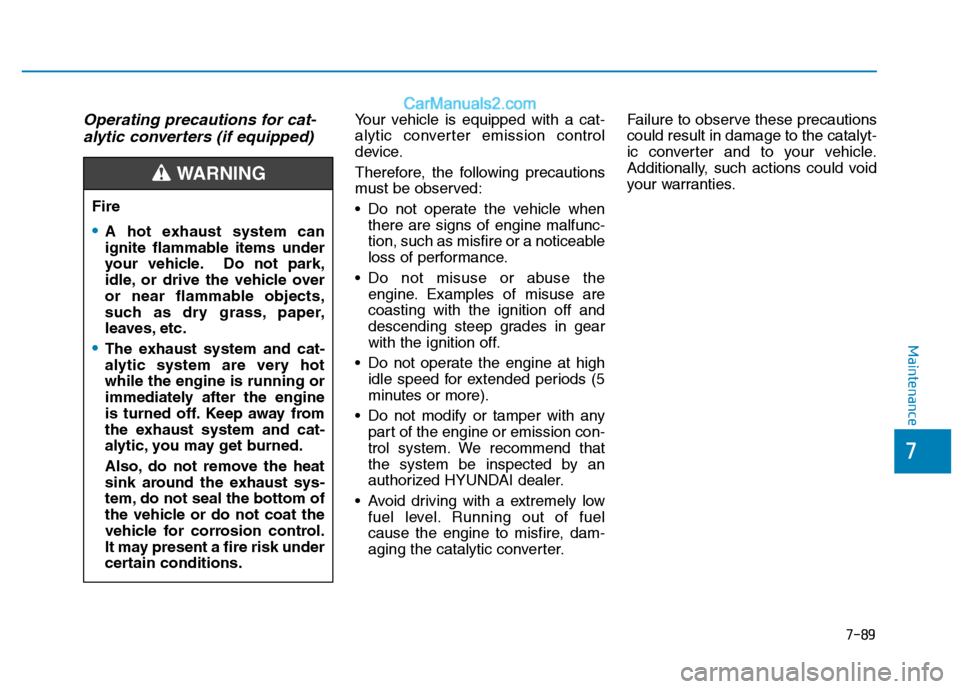
7-89
7
Maintenance
Operating precautions for cat-alytic converters (if equipped)Your vehicle is equipped with a cat-
alytic converter emission control
device.
Therefore, the following precautions
must be observed:
Do not operate the vehicle when there are signs of engine malfunc-
tion, such as misfire or a noticeable
loss of performance.
Do not misuse or abuse the engine. Examples of misuse arecoasting with the ignition off and
descending steep grades in gear
with the ignition off.
Do not operate the engine at high idle speed for extended periods (5
minutes or more).
Do not modify or tamper with any part of the engine or emission con-
trol system. We recommend that
the system be inspected by an
authorized HYUNDAI dealer.
Avoid driving with a extremely low fuel level. Running out of fuel
cause the engine to misfire, dam-
aging the catalytic converter. Failure to observe these precautionscould result in damage to the catalyt-
ic converter and to your vehicle.
Additionally, such actions could void
your warranties.
Fire
A hot exhaust system can
ignite flammable items under
your vehicle. Do not park,
idle, or drive the vehicle over
or near flammable objects,
such as dry grass, paper,
leaves, etc.
The exhaust system and cat-
alytic system are very hotwhile the engine is running or
immediately after the engine
is turned off. Keep away from
the exhaust system and cat-
alytic, you may get burned.
Also, do not remove the heat
sink around the exhaust sys-
tem, do not seal the bottom of
the vehicle or do not coat the
vehicle for corrosion control.
It may present a fire risk under
certain conditions.
WARNING
Page 453 of 473
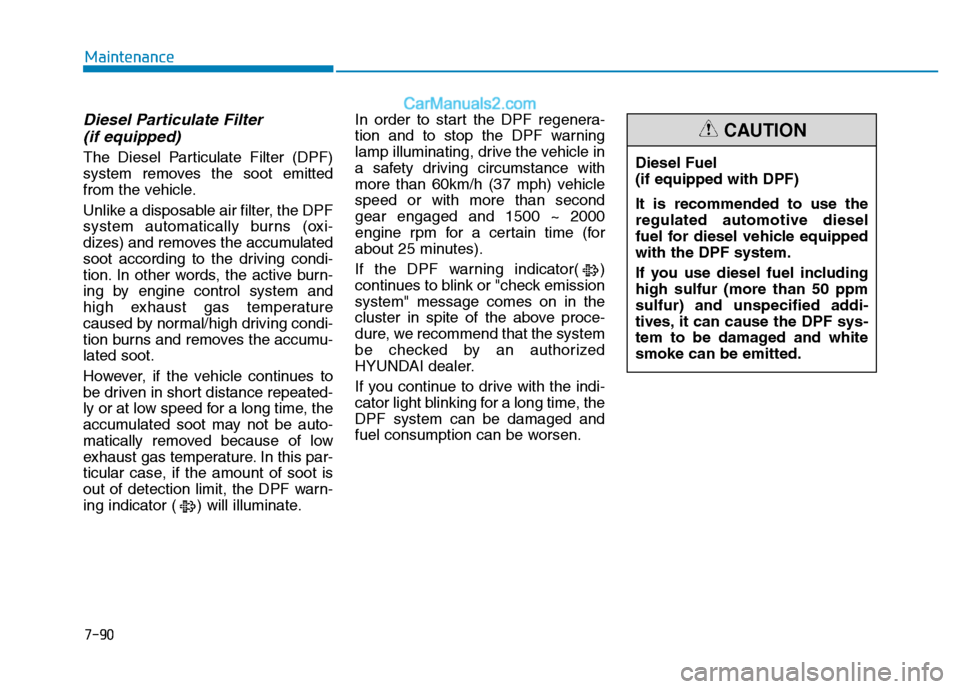
7-90
Maintenance
Diesel Particulate Filter (if equipped)
The Diesel Particulate Filter (DPF)
system removes the soot emitted
from the vehicle.
Unlike a disposable air filter, the DPF
system automatically burns (oxi-
dizes) and removes the accumulated
soot according to the driving condi-
tion. In other words, the active burn-
ing by engine control system and
high exhaust gas temperature
caused by normal/high driving condi-
tion burns and removes the accumu-lated soot.
However, if the vehicle continues to
be driven in short distance repeated-
ly or at low speed for a long time, the
accumulated soot may not be auto-
matically removed because of low
exhaust gas temperature. In this par-
ticular case, if the amount of soot is
out of detection limit, the DPF warn-
ing indicator ( ) will illuminate. In order to start the DPF regenera-
tion and to stop the DPF warning
lamp illuminating, drive the vehicle in
a safety driving circumstance with
more than 60km/h (37 mph) vehiclespeed or with more than secondgear engaged and 1500 ~ 2000
engine rpm for a certain time (for
about 25 minutes).
If the DPF warning indicator( )
continues to blink or "check emissionsystem" message comes on in the
cluster in spite of the above proce-
dure, we recommend that the system
be checked by an authorized
HYUNDAI dealer.
If you continue to drive with the indi-
cator light blinking for a long time, theDPF system can be damaged and
fuel consumption can be worsen.Diesel Fuel (if equipped with DPF) It is recommended to use the regulated automotive diesel
fuel for diesel vehicle equippedwith the DPF system.
If you use diesel fuel including high sulfur (more than 50 ppm
sulfur) and unspecified addi-
tives, it can cause the DPF sys-
tem to be damaged and whitesmoke can be emitted.
CAUTION
Page 454 of 473
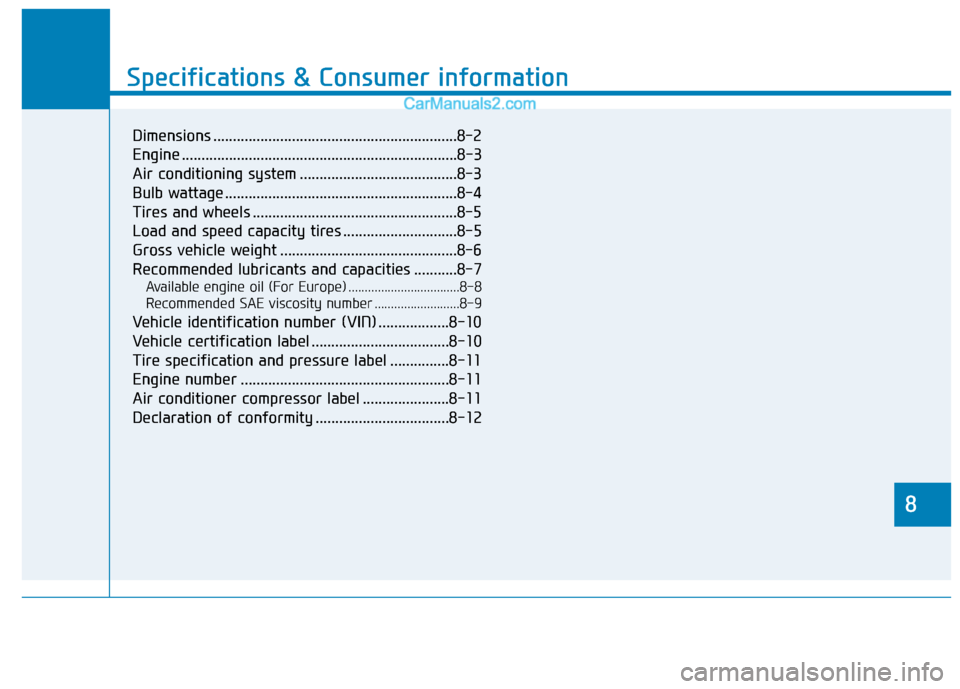
8
Specifications & Consumer information
8
Specifications & Consumer information
8
Dimensions ..............................................................8-2
Engine ......................................................................8-3
Air conditioning system ........................................8-3
Bulb wattage ...........................................................8-4
Tires and wheels ....................................................8-5
Load and speed capacity tires .............................8-5
Gross vehicle weight .............................................8-6
Recommended lubricants and capacities ...........8-7Available engine oil (For Europe) ..................................8-8
Recommended SAE viscosity number ..........................8-9
Vehicle identification number (VIN) ..................8-10
Vehicle certification label ...................................8-10
Tire specification and pressure label ...............8-11
Engine number .....................................................8-11
Air conditioner compressor label ......................8-11
Declaration of conformity ..................................8-12
Page 455 of 473
![Hyundai H350 2015 Owners Manual 8-2
Specifications & Consumer informationD
D IIMM EENN SSIIOO NNSS
unit : mm (in)
ITEMBUSVA NTr u c k
LongShortLongShort
Overall length
[With rear step]6,195 (243.9)6,195 (243.9)
[6,365 (250.6)]5,515 Hyundai H350 2015 Owners Manual 8-2
Specifications & Consumer informationD
D IIMM EENN SSIIOO NNSS
unit : mm (in)
ITEMBUSVA NTr u c k
LongShortLongShort
Overall length
[With rear step]6,195 (243.9)6,195 (243.9)
[6,365 (250.6)]5,515](/img/35/14886/w960_14886-454.png)
8-2
Specifications & Consumer informationD
D IIMM EENN SSIIOO NNSS
unit : mm (in)
ITEMBUSVA NTr u c k
LongShortLongShort
Overall length
[With rear step]6,195 (243.9)6,195 (243.9)
[6,365 (250.6)]5,515 (217.1)
[5,685 (223.9)]6,167 (242.8)5,724 (225.4)
Overall width
[With outside rear view mirror]2,038 (80.2)
[2,436 (96.0)]2,038 (80.2)
[2,436 (96.0)]2,038 (80.2)
[2,436 (96.0)]2,038 (80.2)
[2,436 (96.0)]2,038 (80.2)
[2,436 (96.0)]
Overall height
Roof panel2,665 (105.0)2,690 (106.0)2,685 (105.7)2,320 (91.3)2,320 (91.3)
Roof hatch2,673 (105.2)----
Electric vent2,777 (109.3)----
A/CON2,856 (111.6)----
Front tread1,712 (67.4)1,712 (67.4)1,712 (67.4)1,712 (67.4)1,712 (67.4)
Rear tread1,718 (67.6)1,718 (67.6)1,718 (67.6)1,718 (67.6)1,718 (67.6)
Wheelbase3,670 (144.5)3,670 (144.5)3,435 (135.2)3,670 (144.5)3,435 (135.2)
Page 456 of 473
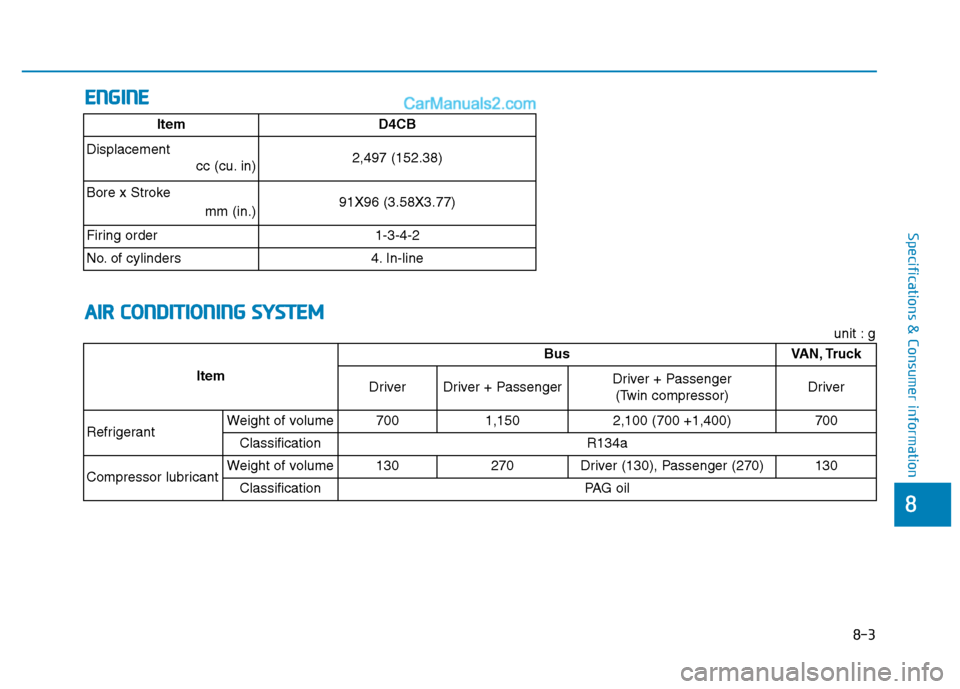
8-3
8
Specifications & Consumer information
EENN GGIINN EE
A
A IIRR CC OO NNDDIITT IIOO NNIINN GG SS YY SSTT EEMM
ItemD4CB
Displacement cc (cu. in)
2,497 (152.38)
Bore x Stroke mm (in.)
91X96 (3.58X3.77)
Firing order
1-3-4-2
No. of cylinders
4. In-line
Item Bus VAN, Truck
Driver Driver + Passenger Driver + Passenger
(Twin compressor) Driver
Refrigerant
Weight of volume 700 1,150 2,100 (700 +1,400) 700
Classification R134a
Compressor lubricant
Weight of volume 130 270 Driver (130), Passenger (270) 130
Classification PAG oil
unit : g
Page 457 of 473
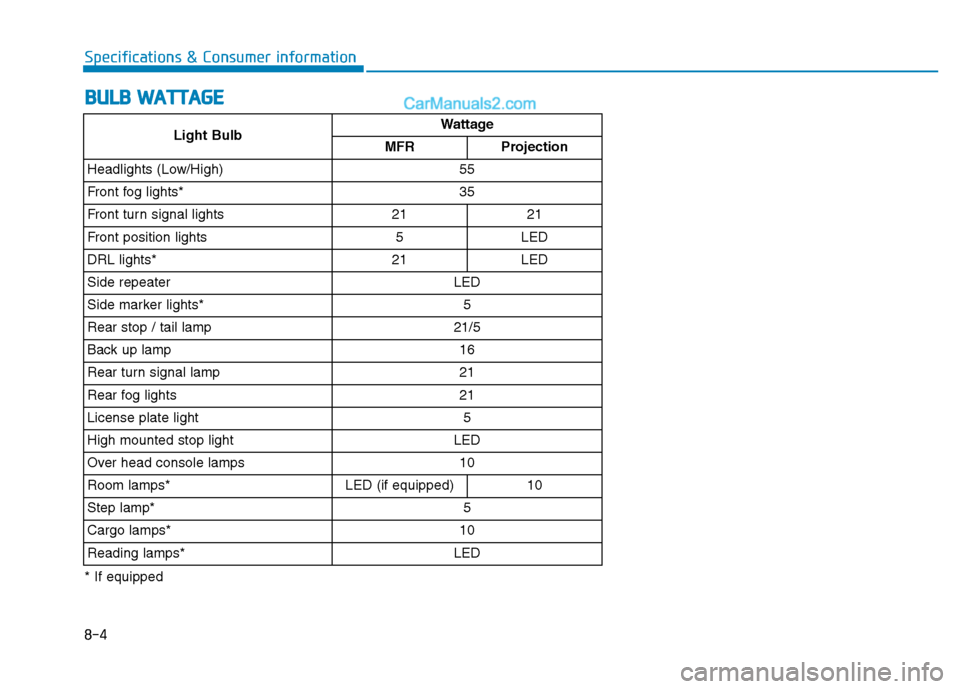
8-4
Specifications & Consumer informationB
B UU LLBB WW AATTTTAA GG EE
* If equipped
Light BulbWattage
MFRProjection
Headlights (Low/High)55
Front fog lights*35
Front turn signal lights2121
Front position lights5LED
DRL lights*21LED
Side repeaterLED
Side marker lights*5
Rear stop / tail lamp21/5
Back up lamp16
Rear turn signal lamp21
Rear fog lights21
License plate light5
High mounted stop lightLED
Over head console lamps10
Room lamps*LED (if equipped)10
Step lamp*5
Cargo lamps*10
Reading lamps*LED
Page 458 of 473
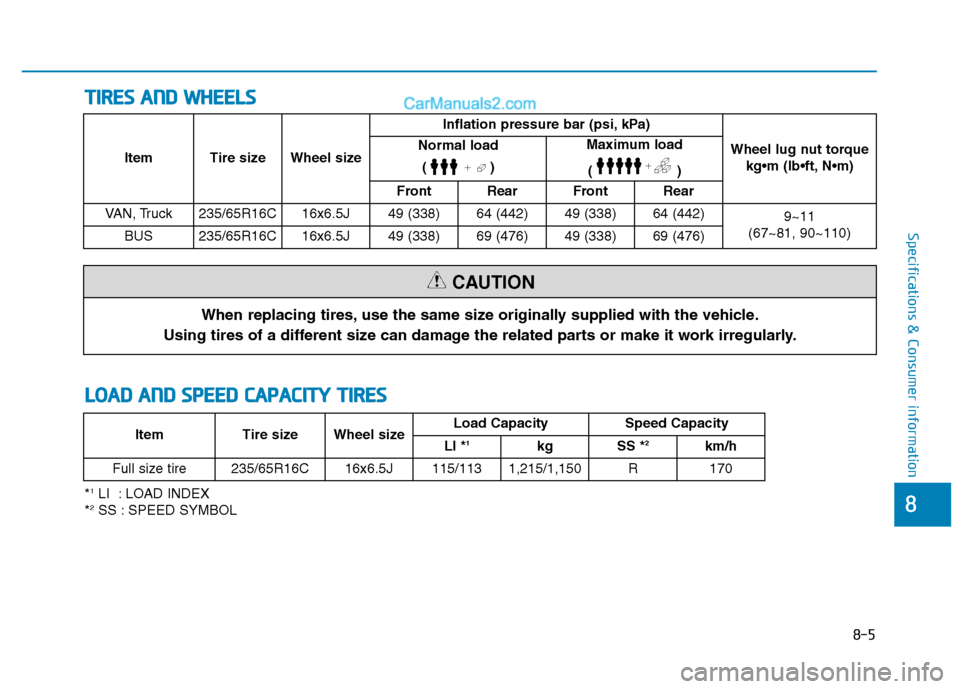
8-5
8
Specifications & Consumer information
TTIIRR EESS AA NN DD WW HHEEEELLSS
When replacing tires, use the same size originally supplied with the vehicle.
Using tires of a different size can damage the related parts or make it work irregularly.
CAUTION
LL OO AADD AA NN DD SS PP EEEEDD CC AA PPAA CCIITT YY TT IIRR EESS
Item Tire size Wheel size Inflation pressure bar (psi, kPa)
Wheel lug nut torquekg•m (lb N
Normal load
()Maximum load
()
Front Rear Front Rear
VAN, Truck 235/65R16C 16x6.5J 49 (338) 64 (442) 49 (338) 64 (442) 9~11
(67~81, 90~110)
BUS 235/65R16C 16x6.5J 49 (338) 69 (476) 49 (338) 69 (476)
* 1
LI : LOAD INDEX
* 2
SS : SPEED SYMBOL Item Tire size Wheel size
Load Capacity Speed Capacity
LI * 1
kg SS * 2
km/h
Full size tire 235/65R16C 16x6.5J 115/113 1,215/1,150 R 170
Page 459 of 473
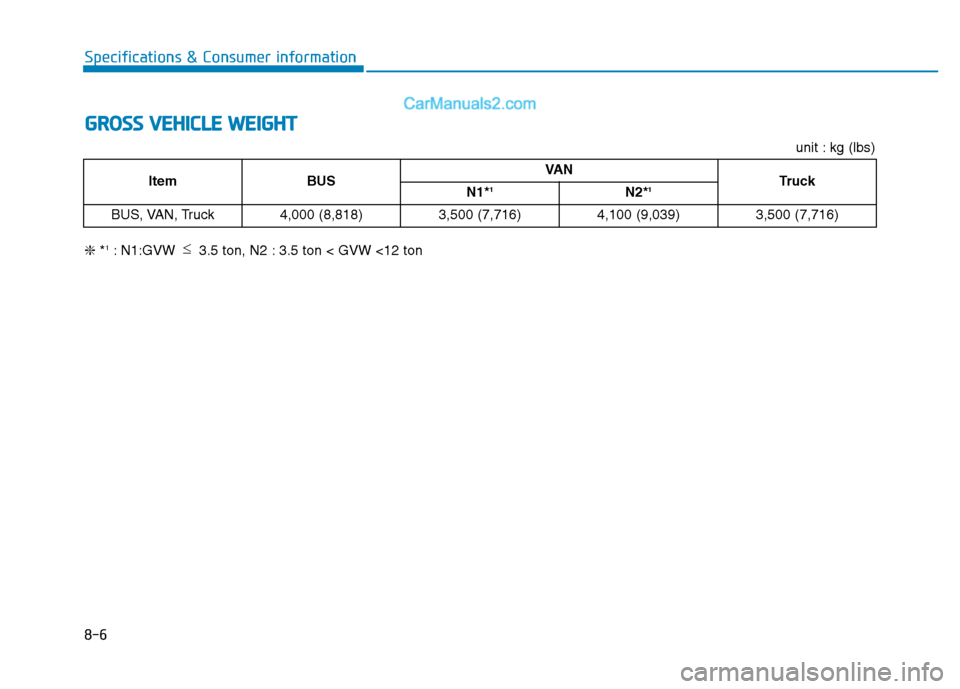
8-6
Specifications & Consumer informationG
G RROO SSSS VV EEHH IICC LLEE WW EEIIGG HH TT
Item BUS VA N
Tr u c k
N1* 1
N2*1
BUS, VAN, Truck 4,000 (8,818) 3,500 (7,716) 4,100 (9,039) 3,500 (7,716)
unit : kg (lbs)
❇ *1
: N1:GVW 3.5 ton, N2 : 3.5 ton < GVW <12 ton
�
Page 460 of 473
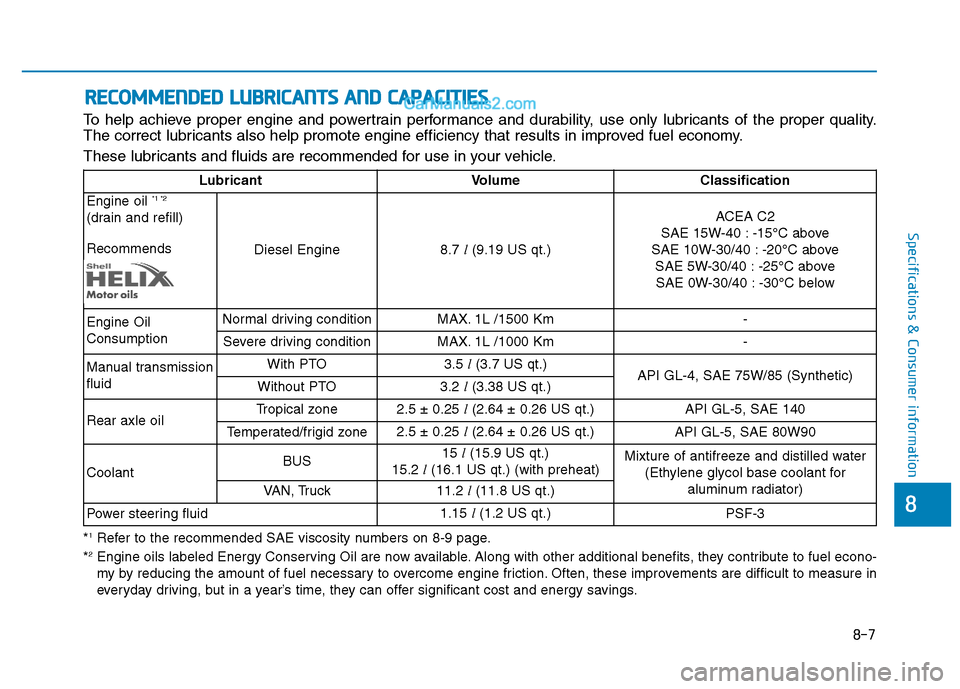
8-7
8
Specifications & Consumer information
RREECCOO MM MMEENN DDEEDD LL UU BBRRIICC AA NN TTSS AA NN DD CC AA PPAA CCIITT IIEE SS
To help achieve proper engine and powertrain performance and durability, use only lubricants of the proper quality.
The correct lubricants also help promote engine efficiency that results in improved fuel economy.
These lubricants and fluids are recommended for use in your vehicle.
LubricantVolume Classification
Engine oil *1 *2
(drain and refill) Recommends
Diesel Engine8.7 l(9.19 US qt.)
ACEA C2
SAE 15W-40 : -15°C above
SAE 10W-30/40 : -20°C above SAE 5W-30/40 : -25°C aboveSAE 0W-30/40 : -30°C below
Engine Oil ConsumptionNormal driving conditionMAX. 1L /1500 Km-
Severe driving conditionMAX. 1L /1000 Km-
Manual transmission fluidWith PTO3.5 l(3.7 US qt.)API GL-4, SAE 75W/85 (Synthetic)Without PTO3.2 l(3.38 US qt.)
Rear axle oilTropical zone2.5 ± 0.25 l(2.64 ± 0.26 US qt.)API GL-5, SAE 140
Temperated/frigid zone2.5 ± 0.25 l(2.64 ± 0.26 US qt.)API GL-5, SAE 80W90
Coolant BUS15 l(15.9 US qt.)
15.2 l(16.1 US qt.) (with preheat)Mixture of antifreeze and distilled water
(Ethylene glycol base coolant for aluminum radiator)
VAN, Truck11.2 l(11.8 US qt.)
Power steering fluid1.15 l(1.2 US qt.)PSF-3
*1
Refer to the recommended SAE viscosity numbers on 8-9 page.
* 2
Engine oils labeled Energy Conserving Oil are now available. Along with other additional benefits, they contribute to fuel econo -
my by reducing the amount of fuel necessary to overcome engine friction. Often, these improvements are difficult to measure in
everyday driving, but in a year’s time, they can offer significant cost and energy savings.